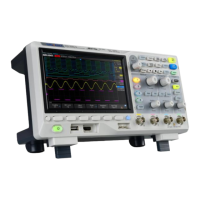SDS1000X-E User Manual
38
Overview
To understand the oscilloscope's sampling and acquisition modes, it is helpful to
understand sampling theory, sample rate and oscilloscope bandwidth and sample rate.
Sampling Theory
The Nyquist sampling theorem states that for a limited bandwidth (band- limited) signal
with maximum frequency f
MAX
, the equally spaced sampling frequency f
S
must be greater
than twice the maximum frequency f
MAX
, in order to have the signal be uniquely
reconstructed without aliasing.
f
MAX
= f
S/2
= Nyquist frequency (f
N
) = folding frequency
Sample Rate
The maximum sample rate of the oscilloscope is 2GSa/s. The actual sample rate of the
oscilloscope is determined by the horizontal scale. Turn the Horizontal Scale Knob to
adjust the sample rate.
The actual sample rate is displayed in the information area at the upper- right corner of the
screen.
The influence on the waveform when the sample rate is too low:
1. Waveform Distortion: when the sample rate is too low, some waveform details are
lost and the waveform displayed is rather different from the actual signal.
2. Waveform Confusion: when the sample rate is lower than twice the actual signal
frequency (Nyquist Frequency), the frequency of the waveform rebuilt from the sample
data is lower than the actual signal frequency. The most common aliasing is the jitter
on fast edge.

